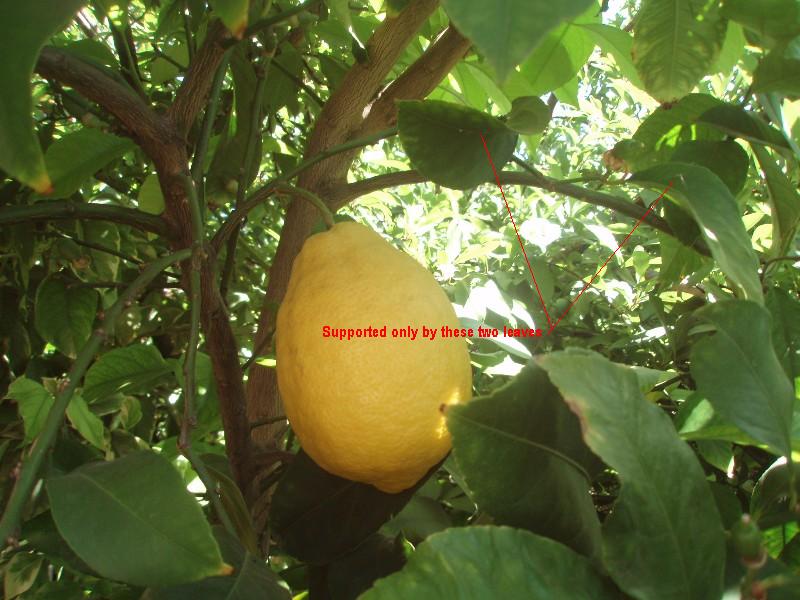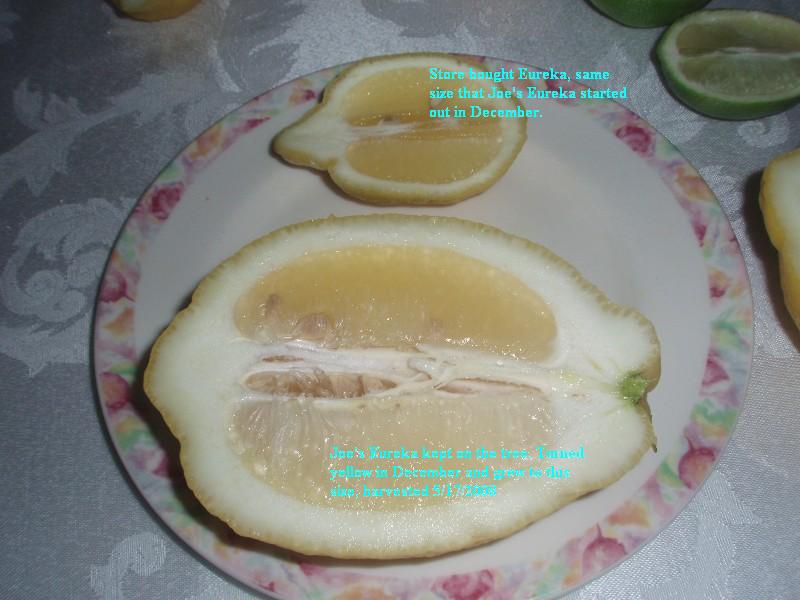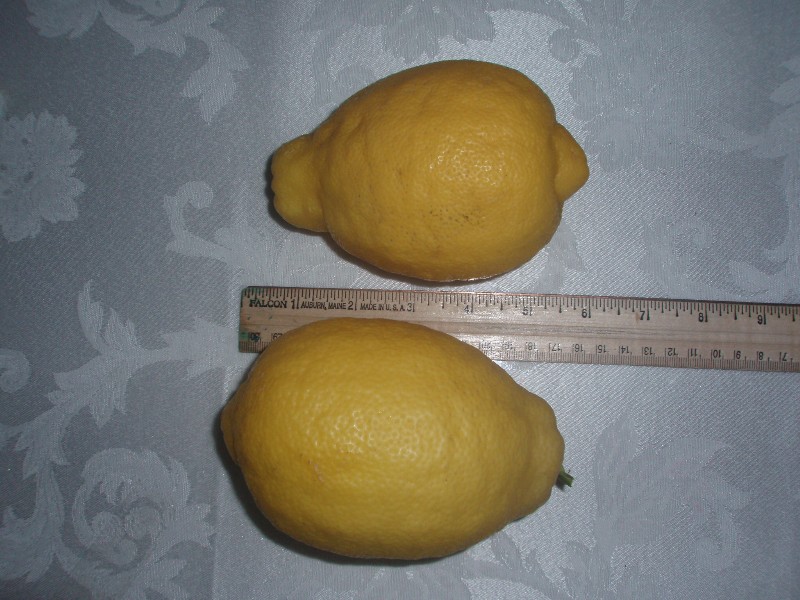 |
Citrus Growers Forum
This is the read-only version of the Citrus Growers Forum.
Breaking news: the Citrus Growers Forum is reborn from its ashes!
Citrus Growers v2.0
|
|
|
|
| Author |
Message |
JoeReal
Site Admin


Joined: 16 Nov 2005
Posts: 4726
Location: Davis, California
|
| Posted: Fri 16 May, 2008 5:47 pm |
|
Sometimes, just like most other citruses, the lemon can regreen, although only partially, from what I have observed, as the weather warms up, and you let them stay on the tree, and some lemon cultivar fruits can grow bigger in size.
Thus it is not quite accurate that they have stopped growing as they started to turn to yellow color. |
|
| Back to top |
|
 |
Millet
Citruholic


Joined: 13 Nov 2005
Posts: 6657
Location: Colorado
|
| Posted: Fri 16 May, 2008 6:27 pm |
|
.Joe, ..........therefore stopped, or practically stopped growing........ is an accurate term for commercial picking, especially for a profit minded industry. In door yard terms, a lemon may possibly enlarge a little. That is why the word "practically" is included. - Millet |
|
| Back to top |
|
 |
JoeReal
Site Admin


Joined: 16 Nov 2005
Posts: 4726
Location: Davis, California
|
| Posted: Fri 16 May, 2008 7:37 pm |
|
| Millet wrote: | | .Joe, ..........therefore stopped, or practically stopped growing........ is an accurate term for commercial picking, especially for a profit minded industry. In door yard terms, a lemon may possibly enlarge a little. That is why the word "practically" is included. - Millet |
Some of my Lisbon fruits practically doubed in volume since December, and I don't think that's a little. But I agree with you if we put it into a commercial perspective. It is not practical to allow lemons to grow to that size and require almost half a year to do so, and in that sense, the growth rate is negligble to be profitable.
I do apologize if I have to interject some statements that seem to contradict the commercial perspective, as many of us, including yourself are great citrus hobbyists. Usually there is a disparity between for profit commercial citrus production versus hobbyists. Even among hobbyists we have diversified objectives. It just goes to show that some of us spend inordinate amount of time observing our plants. |
|
| Back to top |
|
 |
Millet
Citruholic


Joined: 13 Nov 2005
Posts: 6657
Location: Colorado
|
| Posted: Fri 16 May, 2008 7:51 pm |
|
Joe, feel free to interject any information at any time. Personally, I have never seen any of the lemons that I have ever grown double in size after the fruit has turned yellow. Maybe I should introduce my trees to your 80-in-1 tree. Take care. - Millet |
|
| Back to top |
|
 |
JoeReal
Site Admin


Joined: 16 Nov 2005
Posts: 4726
Location: Davis, California
|
| Posted: Fri 16 May, 2008 8:59 pm |
|
I know what you meant.
But again, the doubling in volume doesn't necessarily equate to doubling in size, so I intentionally stated it that way. If you for example, increase the length of all dimensions by 2, the volume is in fact increased by 8. The reverse would be that doubling by volume will have on the average, increase the size in linear dimensions by only 26%, or 25.992104989487316476721060727823% to put it more accurately. Practically, just increasing the size, length, width and height by 1/4, would mean that the fruit has almost doubled in volume. So the context of size should be qualified, whether it is linear dimension, area, or volume, that is why I specifically mentioned volume. And although the volume was doubled, the increase in the linear dimension is not phenomenal, just about 26%. |
|
| Back to top |
|
 |
Skeeter
Moderator

Joined: 23 Jul 2006
Posts: 2218
Location: Pensacola, FL zone 9
|
| Posted: Fri 16 May, 2008 11:18 pm |
|
I measured the peel on one of my lemons tonight-- thinnest point 5 mm, thickest point 10 mm. Overall diameter was 8 cm.
_________________
Skeet
 |
|
| Back to top |
|
 |
JoeReal
Site Admin


Joined: 16 Nov 2005
Posts: 4726
Location: Davis, California
|
| Posted: Sat 17 May, 2008 2:38 pm |
|
My Eureka lemons on my multi-grafted lemon tree is showing the same pattern. I've had plenty of lemons starting last November, and when it got really cold, they started to turn yellow. At that time, they were the same size as average lemons from the stores.
I utilized the lemons as time went by as I could not utilize them all at the same time. That is why I have been testing the good keeping ability of various citruses. But suing lemons, I first started using y Meyer lemons from the same tree simply because these are not good keepers as others, and soon that was gone, then the lisbons, as we slowly use them day to day. What I was left are Eurekas, and they have tripled in volume from when they were first started.
They really grew larger. I think the explanation is very simple. As you remove more fruits, you still have a lot of photosynthesis going on, and where do those products go? What is happening as you harvest some fruit as time goes by, you are in fact thinning the tree out. With photosynthesis going on, and the very few fruits that remained have no choice but to grow larger.
I'll take pic as soon as I find the camera.
At the barbecue party yeterday, some of my guests harvested my "giant" size lisbon lemons from my 80-n-1 tree before I got the chance to dice them up and take pictures of. I may still have a couple left which I hope I can slice and show. |
|
| Back to top |
|
 |
Millet
Citruholic


Joined: 13 Nov 2005
Posts: 6657
Location: Colorado
|
| Posted: Sat 17 May, 2008 3:11 pm |
|
Individual citrus fruit do not rely on the tree's full canopy of leaves, as their source of energy. Citrus fruit rely on the leaves that are in nearby proximity, and not on leaves on the other side of the tree. Photosynthetic activity in the leaves nearby each fruit has long been known to influence the levels of the photosynthates (sugars and other carbohydrates) required for growth and taste. A still closer tie recently has been found between the photosynthesis in single leaves near citrus fruit , and sugars translocated into the exact fruit sections that are vertically aligned with the leaf. In other words, a nearby leaf that is just above the north west portion of a fruit, sends 90% of its photosynthates (sugars) into only the north west portion of that fruit. Further examination of individual juice segments within the fruit has shown that most of these photosynthates produced by the single leaf move into only one or two of the fruits segments that are also in alignment with the manufacturing leaf. The photosynthates produced by the tree are used by every part of the tree's structure for life. Much of the photosynthates goes into the tree's storage system for later use when needed. As the crop is harvested from the tree, the transportation system, does not realign itself to send an ever increasing supply of photosynthates into the remaining fruit. Thinning the crop does increase the fruit size of the remaining fruit, but the energy still comes for the leaves in close proximity. - Millet |
|
| Back to top |
|
 |
JoeReal
Site Admin


Joined: 16 Nov 2005
Posts: 4726
Location: Davis, California
|
| Posted: Sat 17 May, 2008 3:47 pm |
|
Yes, we have done such isotope tracking and studies of even various plants. It is mostly true, but it has not been tested in ways to make such generalization. In fact long distance translocation of many products of photosynthesis and stored nutrients and chemicals happen in citruses, all the time. I will tell how this is routinely happening, but wanted you think how they could be happening. |
|
| Back to top |
|
 |
Millet
Citruholic


Joined: 13 Nov 2005
Posts: 6657
Location: Colorado
|
| Posted: Sat 17 May, 2008 4:38 pm |
|
The roots, branches and the trunk of citrus trees store a lot of photosynthates. The delivery of nutrients from the roots through the transpiration system to the foliage has to be the longest supply chain in the tree. My only point is that as the fruit load is diminished by harvest, the increase of pohosynthates to the remaining fruit still comes from locally manufactured photosynthates, and not from leaves growing on the distal portion of the tree. Agreed that long distance translocation of many products of photosynthesis and stored nutrients happen in citruses all the time, but generally these nutritive elements, are not directed into individual fruits, which must still rely on local leaves. - Millet |
|
| Back to top |
|
 |
JoeReal
Site Admin


Joined: 16 Nov 2005
Posts: 4726
Location: Davis, California
|
| Posted: Sat 17 May, 2008 6:46 pm |
|
Precisely Millet! And I agree with the local leaves as being the supplier. But the tree is adaptable and also has opportunistic tendency. Whenever there is stress, an oversupply of nutrients, plants somehow manage to turn on its long distance translocation mechanisms.
Below is one of my last batch of lemons that matured between November to December of 2007. It used to have other lemons with it but they were harvested. This was the second to the last one left on the tree. This one is deeper in the canopy, and the stem has only two leaves, and it has a small lemon fruitlet growing on that tiny branch. I don't think that the two leaves were enough to let it attain that size of a lemon, and the fact that there were two other mature lemons along in that cluster but were harvested in February and April. So with only two leaves which are mostly shaded out, as they are located in the center of the plant canopy, translocation from nearby branches would have supplied most of the needed food and nutrients. And then there is a new fruitlet forming.
Joe's Eureka Lemon:

By joereal at 2008-05-17 |
|
| Back to top |
|
 |
JoeReal
Site Admin


Joined: 16 Nov 2005
Posts: 4726
Location: Davis, California
|
| Posted: Sat 17 May, 2008 7:26 pm |
|
And as promised earlier, here's how my Eureka Lemon grew to the size. And the size increase is no joke. It has grown by 370% in terms of volume, compared to when it first turned yellow in December.

By joereal at 2008-05-17
The picture below shows how my Eureka lemon compared with the store bought Eureka lemon. Take visual comparisons of rind thickness, and sizes. Joe's Eureka lemon is below the ruler. And above the ruler, from left to right are Store-bought Eureka lemon, Joe's Bearss Lime, and the Mary Ellen Sweet Lime (actually it is not close to sweet, and not tart either, but bland!).

By joereal at 2008-05-17
My Eureka lemon had other "siblings" with it on the same branch. Around December, they turned color, and they were usable for various recipes. They also started out to have just slightly bigger size than the store bought Eureka lemon that I got today. As I started picking out the siblings of this lemon, whatever was left behind continued to grow. Their rinds also got thicker as they grow larger.
Here's some interesting comparisons by the numbers:
Joe's Eureka lemon is almost 5 times in volume as that of the store bought Eureka lemon. The average rind thickness is about three times than that of store bought lemon.
Linear dimensions and volume
Joe's Eureka Lemon: 5.25" x 3.5" x 3.75" => 36.08 cubic inches (volume based on ellipsoid shape, 4/3 pi abc).
Eureka from store: 3.25" x 2.125" x 2.125" => 7.68 cubic inches
Bearss lime: 2.625" x 1.875" x 1.875" => 4.83 cubic inches
Sweet lime: 2.25" x 1.9375" x 1.875" => 4.28 cubic inches
Rind thickness average.
Joe's Eureka: 15.67 mm => 29% of linear dimension (count both sides of the fruit)
store Eureka: 5.67 mm => 17.6% of linear dimension
Bearss Lime: 5.33 mm => 9.6% of linear dimension
Sweet Lime: 4.33 mm => 16.4% of linear dimension.
At the get go, we can see that Joe's Eureka has about three times the rind thickness. But some would argue that because proportionally, it is bigger, but let us normalize the comparison for the increased size and express the rind in proportion to linear dimension of the fruit. It still shows that Joe's Eureka lemon has thicker rind in proportion to its size. The Sweet lime relatively speaking, although has thinner rind than Bearss lime, has thicker rind in proportion to its size.
This has supported all of my observations that my Eureka lemon continued to grow SIGNIFICANTLY, growing at least 370% more than when it started out as you slowly harvest fruits through time from its original cluster. The remaining fruits grew. The comparison here is just an illustration as I did not have the fruits from the same branches, to show at the same time. At least with picture of fruits as they are harvested from the same cluster, it would be more convincing. Hopefully, I will find the time to repeat next year with much better comparison, this time pictures sequenced by date of harvest.
Things that I observed to increase in size after they changed color or mature and left to keep on the tree: Navels, Satsumas (but only the peels grew bigger, it just will have a lot of air spaces), the Gold Series of Mandarins (Yosemite, Shasta, Tahoe), Calamondins, Lemons (Eureka and Lisbon, but not Meyer). There are only a quite few.
Just off the top of my head, those I have observed that did not increase in size (There's lots of them, majority of my citruses did not increase fruit size when left on the tree: Meyer lemon, Bearss Lime, Key lime, Sweet Limes, Kumquats and their hybrids, Valencias, blood oranges, Clementines, Tangelos and their hybrids too, other Mandarins, Oro Blancos, Grapefruits, etc). |
|
| Back to top |
|
 |
Millet
Citruholic


Joined: 13 Nov 2005
Posts: 6657
Location: Colorado
|
| Posted: Sat 17 May, 2008 8:15 pm |
|
Interesting indeed. Concerning the "two leaf" lemon, I assume that the branch had more than just the two leaves. Further, I do not know how much photosynthates a single leaf produces, nor do I know how many leaves an average fruit utilizes. The reason for the smaller commercial lemons, or course, is that they are picked to meet "official" packing sizes. therefore they are harvested long before they reach the size of the ones that you leave hanging on your tree. Many commerical lemons are picked before they turn yellow, then are colored in the packing house. Still to know the amount or if any additional growth AFTER the fruit turns yellow, one would need to tag a sample lot of fruit when they are first set, then determine any additional growth after the lemons on your tree have turned yellow. Single fruits do not give much information concerning the post yellow growth. However, very nice fruit, very nice indeed. BTW, To be commercially classified a tree ripe lemon, the fruit must remain on the tree two weeks after turning deep yellow. Your fruit certainly would give a lot of juice. Thanks for your post, I lear a lot from them. - Millet |
|
| Back to top |
|
 |
Malcolm_Manners
Citrus Guru

Joined: 13 Nov 2005
Posts: 676
Location: Lakeland Florida
|
| Posted: Sat 17 May, 2008 9:37 pm |
|
Some research on Florida-grown oranges showed that most of the carbohydrate in the fruit came from the 3 closest leaves, and virtually all of it from the closest 5 leaves. |
|
| Back to top |
|
 |
JoeReal
Site Admin


Joined: 16 Nov 2005
Posts: 4726
Location: Davis, California
|
| Posted: Sat 17 May, 2008 11:50 pm |
|
I actually have a total of 9 lemon with some larger and others slightly smaller than the one sliced today, and showed the same pattern of growth, with thick rinds. Yesterday, several friends harvested the 6 lisbons which I had planned to take pictures of. I still have one Eureka lemon left on the tree, of almost the same size as the one that I cut earlier, it is going to be for Memorial Day use. And I still have uncut one. The Lisbon and Eureka fruits showed the same pattern of fruit growth. The other significant changes that I have observed is that as they stay longer, the center of the segments starts to develop air gap, and that air gap grows larger through time. Around mid March, there was no air gap, but it developed around mid April.
I did not take single samples myself, this is from today also:

By joereal at 2008-05-17 |
|
| Back to top |
|
 |
| Informations |
 |
Our users have posted a total of 66068 messages
We have 3235 registered members on this websites
|
| Most users ever online was 70 on Tue 30 Oct, 2012 10:12 am |
Powered by phpBB © 2001, 2005 phpBB Group
|
|


































